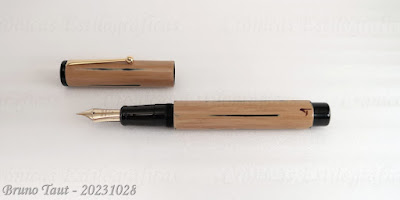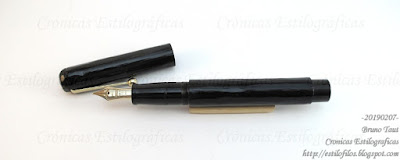(You shall excuse my recent silence on these pages. Some personal issues came in my way and had to pay attention to them. Hopefully I will be able to post more often in the following weeks).
In the last years we have seen how urushi-based decorative techniques have been adopted by a number of craftsmen well beyond the traditional locations in East Asia. Now we see urushi-decorated pens in Poland, Spain, Switzerland, USA, Turkey, India... and probably many more, plus some others waiting to be discovered.
In the meantime, the Japanese scene remains relatively calm. Sure some younger figures have made some beautiful noise –such is the brilliant case of
Bokumondoh—, but there are some others hidden in their own studios scattered all around Japan. And few of them become known beyond their communities and customers.
Such is the case of Mr. Tateo Sato (佐藤建夫, Sato Tateo in Japanese), an urushi master from the mountains of Miyagi, about 350 km North of Tokyo. Mr. Sato was born in Miyagi in 1951 and has been active since very early age, first learning with masters Sawaguchi Shigeru, Nishiya Kazuo and Yamamoto Hideaki; and since 1981 as the head of his own studio in Narako, Miyagi.
And now, thanks to the initiative of
Mr. Uehara Yûichi of Ohashido, another fellow from Miyagi, we can see some of the works of the urushi master. Uehara commissioned Sato Tateo with the decoration of some pens. The result, or part of it, is the following set of four pens:
 The Four Seasons.
The Four Seasons.
The name of the set is “The Four Seasons”, and the pens are individually named after some evocative Japanese word: tsukushi (土筆) for Spring, hotaru (蛍) for Summer, kagerô (蜻蛉) for Autumn, and tokiwa (常盤) for Winter.
 Tsukushi for Spring. Note the signature near the pen end.
Tsukushi for Spring. Note the signature near the pen end.
Tsukushi is a form of horsetail (equisetum) that grows in Spring. Initially it is yellowish in color.
 Fireflies in Summer.
Fireflies in Summer.
Hotaru is firefly. For this pen, Mr Sato used some subtle raden decoration combined with black urushi.
 Dragonflies in Autumn.
Dragonflies in Autumn.
Kagerô is an old word for dragonfly, an insect deeply associated with Autumn in Japan.
 Evergreen Winter.
Evergreen Winter.
Tokiwa, finally, means evergreen、with its usual connotations of youth and longevity.
All four pens are signed with the
kao –stylized signature— of the master.
As for the pen, not much can be said once you know the works of Mr. Uehara. They are regular Ohashido pens made of ebonite with a medium size nib (
big in Sailor terms) made of 21 K gold, manufactured by Sailor.
 The Sailor nib labeled as Ohashido.
The Sailor nib labeled as Ohashido.
Rare as these pens are, they won't become representative of the works made by Uehara and the Ohashido brand, but sure they will become collectibles sought after by aficionados. And maestro Sato might become better known.
My thanks to Poplicola-san.
Parker 50 “Falcon” – Sailor Yama-dori
Bruno Taut
November 6th, 2023
etiquetas: Ohashido, maki-e




























































